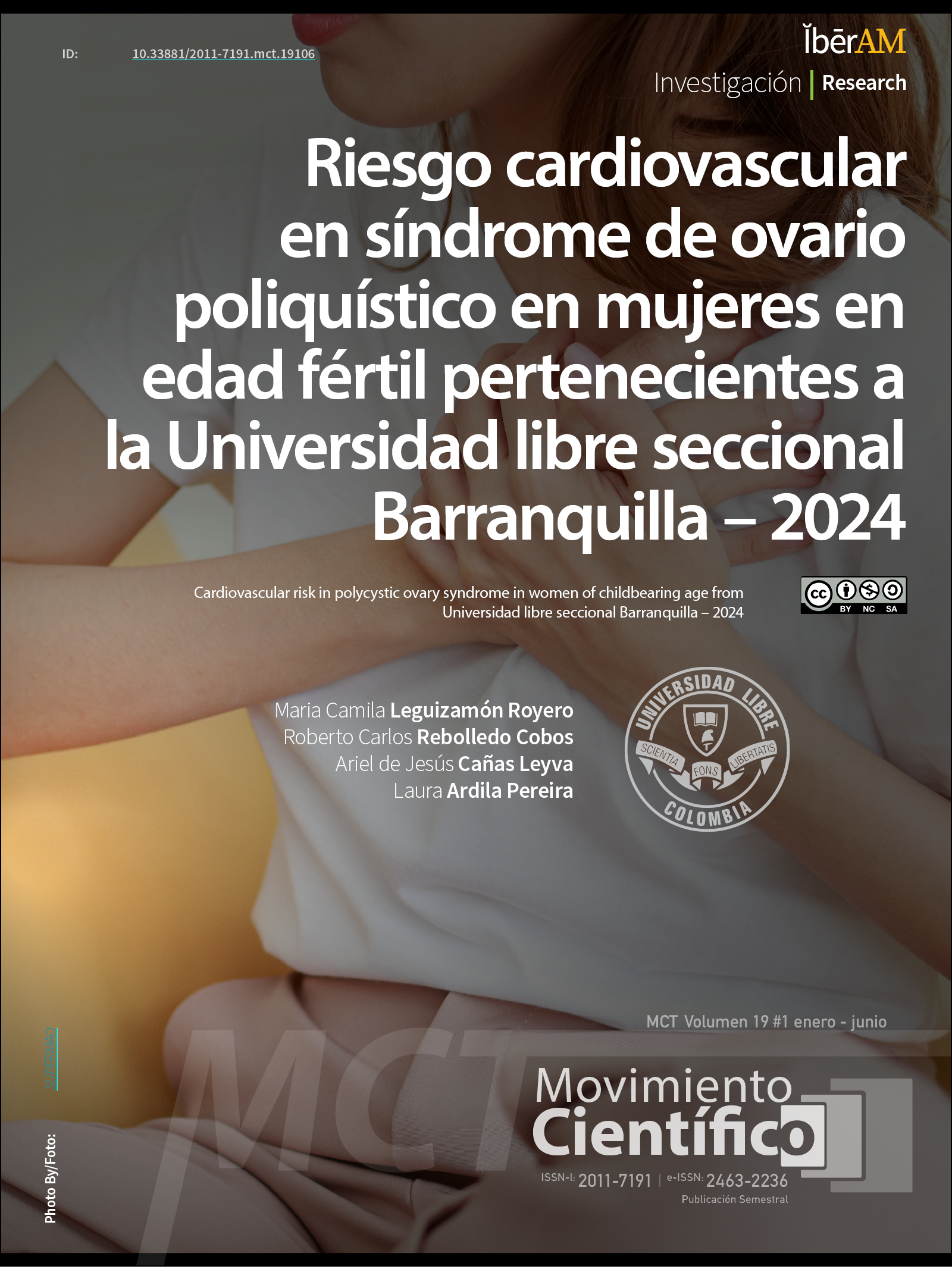Cardiovascular risk in polycystic ovary syndrome in women of childbearing age from Universidad Libre seccional Barranquilla -2024
Riesgo cardiovascular en síndrome de ovário poliquístico en mujeres en edad fértil pertenecientes a la Universidad Libre seccional Barranquilla -2024
Main Article Content
Polycystic ovary syndrome (PCOS) is an endocrine disorder characterized by irregular ovulation, hyperandrogenism, and polycystic ovaries, associated with an increased risk of type 2 diabetes and cardiovascular diseases. This study aims to evaluate the relationship between PCOS and cardiovascular risk in women of reproductive age at Universidad Libre Seccional Barranquilla, Colombia, considering implications for cardiopulmonary risk at older ages. Methods: A cross-sectional descriptive-analytical study was conducted with 346 women aged 16 to 35 from the academic community. Surveys were used to assess personal and family history, and anthropometric and biochemical measurements were taken. Data analysis was performed using SPSS version 23.0. Biases were controlled through standardized procedures and diagnostic criteria. Results: 23.4% of the participants were diagnosed with PCOS, mainly women aged 19 to 25. A higher abdominal perimeter was observed in women with PCOS (76 cm) compared to those without diagnosis (72 cm). Additionally, women with PCOS had a higher prevalence of type 2 diabetes and anemia. Mood disorders were more prevalent among those with a family history of hypertension and anemia. Conclusion: The study confirms a high prevalence of PCOS in the sample and its association with cardiovascular risk factors, including higher abdominal perimeter, type 2 diabetes, and anemia. The need for early diagnosis and comprehensive management is highlighted. Methodological differences with international studies may influence the observed correlation, requiring a more contextualized approach for the Colombian population.
Method: A descriptive analytical cross-sectional study was carried out with 346 women between 16 and 35 years old from the academic community. Surveys were used to evaluate personal and family history, and anthropometric and biochemical measurements were performed. The analysis was performed using SPSS software version 23.0.
Results: 23.4% of the participants were diagnosed with PCOS, mainly women aged 19-25 years. A larger abdominal circumference was found in women with PCOS (76 cm) compared to those not diagnosed (72 cm). Furthermore, women with PCOS had a higher prevalence of type 2 diabetes mellitus and anemia. The prevalence of mood disorders was higher among those with a family history of hypertension and anemia.
Conclusion: The study confirms a high prevalence of PCOS in the sample and its association with cardiovascular risk factors, including a larger abdominal circumference and a history of type 2 diabetes and anemia. These findings highlight the need for early diagnosis and comprehensive management to mitigate risks and improve quality of life. The inconsistencies found suggest the need for additional research to delve deeper into the relationship between PCOS and cardiovascular risk.
Keywords: Polycystic Ovary Syndrome, cardiovascular diseases, risk factors, cardiometabolic risk factors, women
Downloads
Publication Facts
Reviewer profiles N/A
Author statements
Indexed in
-
—
- Academic society
- N/A
- Publisher
- Bogotá: Corporación Universitaria Iberoamericana
Article Details
Álvarez Cosmea, A. (2001). Las tablas de riesgo cardiovascular: Una revisión crítica. Medifam, 11(3), 20–51. https://doi.org/10.4321/s1131-57682001000300002 DOI: https://doi.org/10.4321/S1131-57682001000300002
Centros para el Control y la Prevención de Enfermedades. (2024, abril 18). La diabetes y el síndrome del ovario poliquístico (PCOS). Recuperado de https://www.cdc.gov/diabetes/es/risk-factors/la-diabetes-y-el-sindrome-del-ovario-poliquistico-pcos.html
Chang, S., & Dunaif, A. (2021). Diagnosis of polycystic ovary syndrome: Which criteria to use and when? Endocrinology and Metabolism Clinics of North America, 50(1), 11–20. https://doi.org/10.1016/j.ecl.2020.10.002 DOI: https://doi.org/10.1016/j.ecl.2020.10.002
Espitia De La Hoz, F. J. (2022). Características clínicas, hormonales, bioquímicas y prevalencia del síndrome de ovario poliquístico en mujeres del Eje Cafetero, Colombia, 2016-2020. Revista Colombiana de Endocrinología, Diabetes & Metabolismo, 9(4). https://doi.org/10.53853/encr.9.4.772 DOI: https://doi.org/10.53853/encr.9.4.772
Fundación Española del Corazón. (2012). ¿Cómo afecta nuestro estado emocional a la salud cardiovascular? Recuperado de https://fundaciondelcorazon.com/blog-impulso-vital/3344-como-afecta-nuestro-estado-emocional-a-la-salud-cardiovascular.html
Fundación Española del Corazón. (2024). La medida del perímetro abdominal es un indicador de enfermedad cardiovascular más fiable que el IMC. Recuperado de https://fundaciondelcorazon.com/prensa/notas-de-prensa/2264-medida-perimetro-abdominal-es-indicador-enfermedad-cardiovascular-mas-fiable-imc-.html
Legro, R. S., Kunselman, A. R., Dodson, W. C., & Dunaif, A. (1999). Prevalence and predictors of risk for type 2 diabetes mellitus and impaired glucose tolerance in polycystic ovary syndrome: A prospective, controlled study in 254 affected women. The Journal of Clinical Endocrinology and Metabolism, 84(1), 165–169. https://doi.org/10.1210/jcem.84.1.5393 DOI: https://doi.org/10.1210/jc.84.1.165
Mannerås-Holm, L., Leonhardt, H., Kullberg, J., Jennische, E., Odén, A., Holm, G., Hellström, M., Lönn, L., Olivecrona, G., Stener-Victorin, E., & Lönn, M. (2011). Adipose tissue has aberrant morphology and function in PCOS: Enlarged adipocytes and low serum adiponectin, but not circulating sex steroids, are strongly associated with insulin resistance. Journal of Clinical Endocrinology and Metabolism, 96(2), E304–E311. https://doi.org/10.1210/jc.2010-1290 DOI: https://doi.org/10.1210/jc.2010-1290
Martín Moreno, V., Gómez Gandoy, J. B., Gómez de la Cámara, A., & Antoranz González, M. J. (2002). Grasa corporal e índice adiposo-muscular estimados mediante impedanciometría en la evaluación nutricional de mujeres de 35 a 55 años. Revista Española de Salud Pública, 76(6), 723–734. https://doi.org/10.1590/s1135-57272002000600008 DOI: https://doi.org/10.1590/S1135-57272002000600008
Naciones Unidas. (2030). La Agenda 2030 y los Objetivos de Desarrollo Sostenible: Una oportunidad para América Latina y el Caribe. Recuperado de https://www.issuu.com/publicacionescepal/stacks
Organización Mundial de la Salud. (2023). Síndrome de ovario poliquístico. Recuperado de https://www.who.int/es/news-room/fact-sheets/detail/polycystic-ovary-syndrome
Schwab, M., Bloch, J., Duplain, H., Sartori, C., & Scherrer, U. (2008). Defecto en la homeostasis del óxido nítrico. Mecanismo común subyacente de la insulino-resistencia, la hiperactividad simpática y la morbi-mortalidad cardiovascular [Defective nitric oxide homeostasis. Common underlying mechanism between insulin resistance, sympathetic overactivity and cardiovascular morbidity and mortality]. Medicina, 68(3), 243–250.
Sharman, J. E., O'Brien, E., Alpert, B., Schutte, A. E., Delles, C., Hecht Olsen, M., Asmar, R., Atkins, N., Barbosa, E., Calhoun, D., Campbell, N. R. C., Chalmers, J., Benjamin, I., Jennings, G., Laurent, S., Boutouyrie, P., Lopez-Jaramillo, P., McManus, R. J., Mihailidou, A. S., Ordunez, P., … Lancet Commission on Hypertension Group. (2020). Lancet Commission on Hypertension group position statement on the global improvement of accuracy standards for devices that measure blood pressure. Journal of Hypertension, 38(1), 21–29. https://doi.org/10.1097/HJH.0000000000002246 DOI: https://doi.org/10.1097/HJH.0000000000002246
Valentino, G., Bustamante, M. J., Orellana, L., Krämer, V., Durán, S., Adasme, M., Salazar, A., Ibara, C., Fernández, M., Navarrete, C., & Acevedo, M. (2015). Grasa corporal y su relación con la agregación de factores de riesgo cardiovascular. Nutrición Hospitalaria, 31(5). https://doi.org/10.3305/nh.2015.31.5.8625
Zore, T., Joshi, N. V., Lizneva, D., & Azziz, R. (2017). Polycystic ovarian syndrome: Long-term health consequences. Seminars in Reproductive Medicine, 35(3). https://doi.org/10.1055/s-0037-1603096 DOI: https://doi.org/10.1055/s-0037-1603096














